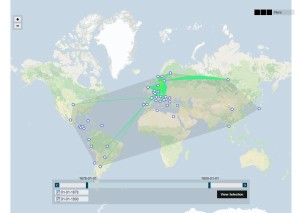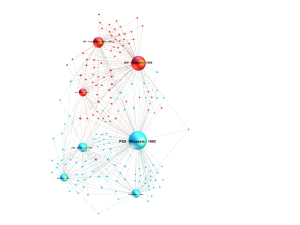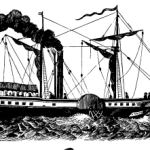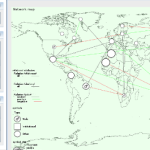Hans Blomme, Nico Randeraad, and Christophe Verbruggen
TIC-Collaborative, Transnational Intellectual Cooperation in the long 19th century
The overall aim of our contribution is to evaluate the digital checks and balances of collaborative research in the study of transnational connections in the field of social reform in the long 19th century.
Between 1815 and 1914 new trans-organizational milieus consisting of journals and conferences became important carriers of ideas and contention. They can be seen as laboratories for the development and diffusion of reformist ideas in Europe.Progressive liberal in origin, conferences for instance were used a part of a repertoire to contest existing power relations and the social and cultural status quo. Our interest ties in with the turn towards a relational and transnational approach in the study of the ideas, actors and networks that shaped welfare state politics and policies in Europe and beyond. Transnational history, however, not only takes place in transnational spaces. We are, therefore, particularly interested in the relations and interactions between the spaces where transnational actors are active and the identification of so called ‘rooted cosmopolitans’, described by Sidney Tarrow and della Porta as “people and groups who are rooted in specific national contexts, but who engage in regular activities that require their involvement in transnational networks of contacts and conflicts”.
We see that while researchers of social reform movements and collective action are increasingly adopting network concepts and perspectives in their work, their use of formal network analytical tools for the exploration how networks of people and discursive frameworks come into existence, is still very limited. This is due to heuristic barriers, such as the identification of comparable sources of data across borders. We are interested in contexts and conditions of knowledge transfer, which we study in networks experts and activists, but also in the knowledge itself: from the theoretical foundations to views and practical ideas. For this purpose it should be possible to mine our sources for changing concepts and discourses. Therefor we have recently founded the Virtual Research Environment (VRE) ‘TIC-Collaborative’ (see www.tic.ugent.be). TIC Collaborative is a Virtual Research Environment for the study of 19th and early 20th century international organizations and congresses. The VRE applies the principle of scholarly crowdsourcing (as already used by eight research units across Europe and 4 PhD students) and offers access to digitized dispersed sources in a central observatory. The platform includes a (1) digital asset management system which will allow the research community to share, annotate and enrich a wide variety of documents, letters, photographs, etc. and (2) a collaborative relational database (in order to process the data for social network analysis, prosopography, etc.). It thus integrates digitized primary sources concerning international congresses (e.g. conference proceedings, reports, lectures and attendees lists), international organizations, and other published and unpublished sources (e.g. yearbooks, periodicals, articles of association, pamphlets, and memoirs).
1. Collaborative digital asset management system. Most digital humanities projects tend to start out from existing collections, thus limiting the degree to which they can operationalize digital techniques to the specific questions that should interest historians. Instead, in our approach the corpus selection is research driven. Therefore we’ve been compiling a corpus of dispersed sources on long 19th century social and legal reform. Our intentions go beyond just compiling the sources, rather we are building a platform that enables the researchers to combine the use of both ‘traditional’ qualitative approaches as well as digital methods. Many of the advanced mining techniques—such as forensic analysis of texts (author recognition), topic modeling, text clustering, named entity recognition—are currently still in an experimental stage, but very recent findings show the exciting potential of for example multi-lingual text-mining in large historical datasets and text corpora (Huijnen et al. 2014). Exploratory searching can provoke new questions and research objectives, but in fact until now it has mainly been used for the confirmation of existing historical knowledge (Gibbs and Owens 2012). We aim to avoid this by using a hybrid approach, combining text mining (topic modeling in particular) with network analysis, data visualization techniquesBörner and Polley 2014) and ‘traditional’ close reading (Verbruggen and Carlier 2014). TIC-collaborative allows the exportation of enriched data in order to perform historical discourse and linguistic analysis with other tools such as NVivo (software for qualitative data analysis) or the Stanford Topic Modeling Toolbox. Cited concepts, persons, publications, and educational experiments are analysed with Sci2 (https://sci2.cns.iu.edu/user/index.php), a toolset specifically designed for spatio-temporal visualization of knowledge circulation.
(2) Another feature of our VRE is a joint relational database, which links international congresses, international organizations, people and publications in order to process the data for social network analysis, cluster analysis, prosopography. During the last several years, various initiatives were initiated to build a structured database about persons, organisations and congresses in the field of social and legal reform, such as at the prosopographical database of magistrates (UCL), TIC (Ghent and Maastricht University), ODIS (www.odis.be; KUL, Ghent and Antwerp University, VUB) and the Europhil group (EHESS, Maastricht University,…). It is our goal to integrate these data in one single platform. We also envisage the exchange/linking of data with other databases and a wide range of query- and export possibilities (Json, XML, xls). This part of the VRE is already operational and uses the ‘Nodegoat’ software. Nodegoat is a web-based database management, analysis and visualisation platform: “Using this system, scholars define, create, query, update, and manage any number of data tables by use of a graphic user interface. Within nodegoat, scholars are able to instantly analyse and visualize data sets (also in space). It allows scholars to enrich data with relational, geographical and temporal attributes. Therefore, the modes of analysis are inherently diachronic and ready-to-use for interactive maps and extensive trailblazing.” (www.nodegoat.net). Next to these built-in functionalities, Nodegoat also enables the researcher to export datasets, ready to use in more advanced visualization software such as Gephi and UCINET (network visualization) or QGIS and ArcGIS (GIS).
Beyond the history of social reform and the attempt to bring particular collections and databases together, the use of a VRE allows the development and assessment of methodologies in the field of digital humanities. Therefor the TIC-Collaborative VRE will serve as a pilot case within the recently founded Flemish/Belgian branch of DARIAH (Digital Research Infrastructure for the Arts and Humanities) (DARIAH-VL/BE). Researchers in the humanities who want to make use of digital analytical tools often face two problems: the tools are developed in an ad hoc manner within the scope of a particular research project and are not evaluated or communicated outside the project context. Secondly, research projects require specific types of scholarly data resources in combination with specific tools. To match tools and research questions is therefore a complex activity. In order to valorize analytical tools better and exchange expertise, DARIAH-VL/BE aims to set up a common standards-based infrastructure offering these tools as a service for all research projects, together with a documentation knowledge base of tools, standards and best practices. In this way, previously developed tools can be reused and may even become ‘standard tools’ in the field. Being a pilot project within DARIAH-VL, TIC-Collaborative will contribute to this.
Download as Word File:
TIC Collaborative – project (2_6_2014) TIC-Collaborative, Transnational Intellectual Cooperation in the long 19th century
Further Material:
TIC Collaborative – project (2_6_2014)
Map for Discussion:


 Previous Post
Previous Post Next Post
Next Post
Dear Hans, Nico, and Christophe,
Your proposal resonates very well with a couple of issues, our own mapping projects within Global Theatre Histories is dealing with. Besides the Wagner project Tobias and I are going to present at the workshop, we are also working on a database and visualization of the expansion of Western purpose-built theatre venues throughout Europe and, more specifically, the colonial world between 1860 and 1950. With this, we would like to show the expansion of theatre as a modern institution and lay a fundament for further research on touring theatre, opera, and vaudeville troupes. In order to be able to collect the necessary data for this, we are also in close contacts with similar mapping and database projects, especially Ausstage (https://www.ausstage.edu.au/pages/browse/), IbsenStage (https://ibsenstage.hf.uio.no/), the Digital Innovation Group of the University of North Carolina and their DH Press project, whose students have prepared a trial with some of our data (http://dhpress.org/), and Doug Reside, digital curator of the NYPL (http://www.nypl.org/online_projects). Quite naturally, data exchange and compatability of different databases has become an important issue for us and Tobias will certainly be happy to discuss our plans and experiences from a technological point of view with you and the others.
Richard Wagner and the huge European and American Wagner movement are certainly also a very interesting example for intellectual networks in the arts. Journals, the Bayreuth Festival as an (almost) annual meeting, touring productions, as well as the infamous Wagner Societies have been important structural elements in the distribution of Wagnerian works and ideas and their linking to wider social movements of artistic and cultural reform. It touches almost the dame time frame as your project (1848-1933) and bears a lot of structural similarities. However, as a “Grenzgänger” phenomenon between arts, politics, and culture, Wagnerians of various generations also develop ideas and controvercies and similar topics within modern discourse.
So, thank you very much for your contribution! I am very much looking forward to meeting you in St Andrews and am sure that we will have a lot of valuable insights and ideas to discuss!
All the best from Munich,
Gero